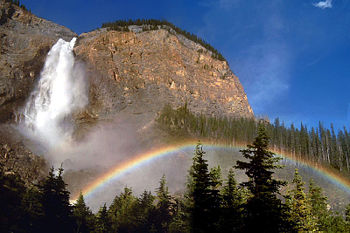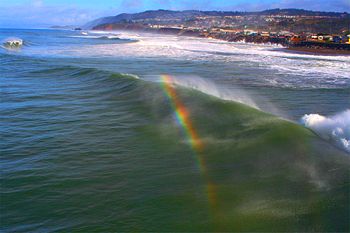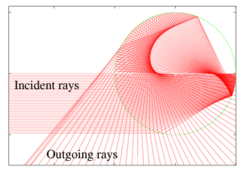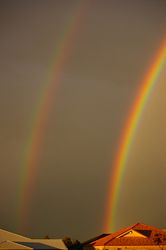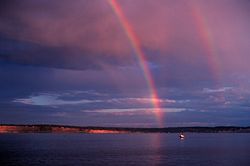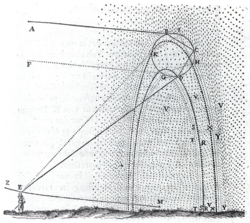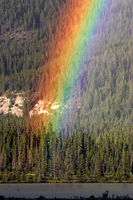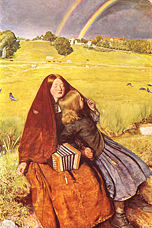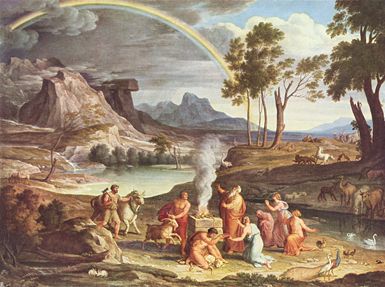Rainbow
2008/9 Schools Wikipedia Selection. Related subjects: Climate and the Weather
Rainbows are optical and meteorological phenomena that cause a spectrum of light to appear in the sky when the Sun shines onto droplets of moisture in the Earth's atmosphere. They take the form of a multicoloured arc, with red on the outer part of the arch and violet on the inner section of the arch. More rarely, a secondary rainbow is seen, which is a second, fainter arc, outside the primary arc, with colours in the opposite order, that is, with violet on the outside and red on the inside.
A rainbow spans a continuous spectrum of colours. Traditionally, however, the sequence is quantised. The most commonly cited and remembered sequence, in English, is Newton's sevenfold red, orange, yellow, green, blue, indigo and violet. " Roy G. Biv" and " Richard Of York Gave Battle In Vain" are popular mnemonics.
Rainbows can be caused by other forms of water than rain, including mist, spray, dew, fog, and ice. Moreover, rainbows can have shapes other than a bow (arc), including stripes, circles, or even flames. (See circumhorizontal arc).
Visibility
Rainbows can be observed whenever there are water drops in the air and sunlight shining from behind a person at a low altitude angle (on the ground). The most spectacular rainbow displays happen when half of the sky is still dark with draining clouds and the observer is at a spot with clear sky in the direction of the Sun. The result is a luminous rainbow that contrasts with the darkened background.
The rainbow effect is also commonly seen near waterfalls or fountains. Rainbow fringes can sometimes be seen at the edges of backlit clouds and as vertical bands in distant rain or virga. The effect can also be artificially created by dispersing water droplets into the air during a sunny day. Rarely, a moonbow, lunar rainbow or night-time rainbow, can be seen on strongly moonlit nights. As human visual perception for colour is poor in low light, moonbows are often perceived to be white.
It is difficult to photograph the complete arc of a rainbow, as this would require an angle of view of 84°. For a 35 mm camera, a lens with a focal length of 19 mm or less wide-angle lens would be required. From an aeroplane, one has the opportunity to see the whole circle of the rainbow, with the plane's shadow in the centre. This phenomenon can be confused with the glory, but a glory is usually much smaller, covering only 5°–20°.
Scientific explanation
The rainbow's appearance is caused by dispersion of sunlight as it goes through raindrops. The light is first refracted as it enters the surface of the raindrop, reflected off the back of the drop, and again refracted as it leaves the drop. The overall effect is that the incoming light is reflected back over a wide range of angles, with the most intense light at an angle of 40°–42°. The angle is independent of the size of the drop, but does depend on its refractive index. Seawater has a higher refractive index than rain water, so the radius of a 'rainbow in sea spray is smaller than a true rainbow. This is visible to the naked eye by a misalignment of these bows.
The amount by which light is refracted depends upon its wavelength, and hence its colour. Blue light (shorter wavelength) is refracted at a greater angle than red light, but because the area of the back of the droplet has a focal point inside the droplet, the spectrum crosses itself, and therefore the red light appears higher in the sky, and forms the outer colour of the rainbow. Contrary to popular belief, the light at the back of the raindrop does not undergo total internal reflection and some light does emerge from the back. However, light coming out the back of the raindrop does not create a rainbow between the observer and the sun because spectra emitted from the back of the raindrop do not have a maximum of intensity, as the other visible rainbows do, and thus the colours blend together rather than forming a rainbow.
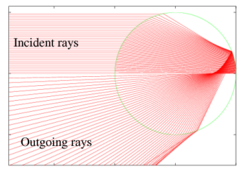
Light rays enter a raindrop from one direction (typically a straight line from the Sun), reflect off the back of the raindrop, and fan out as they leave the raindrop. The light leaving the rainbow is spread over a wide angle, with a maximum intensity of 40.6°–42°.
|
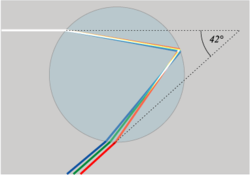
White light separates into different colours ( wavelengths) on entering the raindrop because red light is refracted by a lesser angle than blue light. On leaving the raindrop, the red rays have turned through a smaller angle than the blue rays, producing a rainbow.
|
A rainbow does not actually exist at a particular location in the sky. It is an optical illusion whose apparent position depends on the observer's location and the position of the sun. All raindrops refract and reflect the sunlight in the same way, but only the light from some raindrops reaches the observer's eye. This light is what constitutes the rainbow for that observer. The position of a rainbow in the sky is always in the opposite direction of the Sun with respect to the observer, and the interior is always slightly brighter than the exterior. The bow is centred on the shadow of the observer's head, or more exactly at the antisolar point (which is below the horizon during the daytime), appearing at an angle of 40°–42° to the line between the observer's head and its shadow. As a result, if the Sun is higher than 42°, then the rainbow is below the horizon and cannot be seen as there are not usually sufficient raindrops between the horizon (that is: eye height) and the ground, to contribute. Exceptions occur when the observer is high above the ground, for example in an aeroplane (see above), on top of a mountain, or above a waterfall.
Variations
Occasionally, a second, dimmer, and thicker secondary rainbow is seen outside the primary bow. Secondary rainbows are caused by a double reflection of sunlight inside the raindrops, and appear at an angle of 50°–53°. As a result of the second reflection, the colours of a secondary rainbow are inverted compared to the primary bow, with blue on the outside and red on the inside. The dark area of unlit sky lying between the primary and secondary bows is called Alexander's band, after Alexander of Aphrodisias who first described it.
A third, or tertiary, rainbow can be seen on rare occasions, and a few observers have reported seeing quadruple rainbows in which a dim outermost arc had a rippling and pulsating appearance. These rainbows would appear on the same side of the sky as the Sun, making them hard to spot. One type of tertiary rainbow carries with it the appearance of a secondary rainbow immediately outside the primary bow. The closely spaced outer bow has been observed to form dynamically at the same time that the outermost (tertiary) rainbow disappears. During this change, the two remaining rainbows have been observed to merge into a band of white light with a blue inner and red outer band. This particular form of doubled rainbow is not like the classic double rainbow due to both spacing of the two bows and that the two bows share identical normal colour positioning before merging. With both bows, the inner colour is blue and the outer colour is red.
Higher-order rainbows were described by Felix Billet (1808-1882) who depicted angular positions up to the 19th-order rainbow. A pattern he called “rose” . In the laboratory, it is possible to observe higher-order rainbows by using extremely bright and well collimated light produced by lasers. A sixth-order rainbow was first observed by K. Sassan in 1979 using a HeNe laser beam and a pendant water drop. Up to the 200th-order rainbow was reported by Ng et al. in 1998 using a similar method but an argon ion laser beam .
Supernumerary rainbows
A supernumerary rainbow is an infrequent phenomenon, consisting of several faint rainbows on the inner side of the primary rainbow, and very rarely also outside the secondary rainbow. Supernumerary rainbows are slightly detached and have pastel colour bands that do not fit the usual pattern.
It is not possible to explain their existence using classical geometric optics. The alternating faint rainbows are caused by interference between rays of light following slightly different paths with slightly varying lengths within the raindrops. Some rays are in phase, reinforcing each other through constructive interference, creating a bright band; others are out of phase by up to half a wavelength, cancelling each other out through destructive interference, and creating a gap. Given the different angles of refraction for rays of different colours, the patterns of interference are slightly different for rays of different colours, so each bright band is differentiated in colour, creating a miniature rainbow. Supernumerary rainbows are clearest when raindrops are small and of similar size. The very existence of supernumerary rainbows was historically a first indication of the wave nature of light, and the first explanation was provided by Thomas Young in 1804.
Reflection rainbows, reflected rainbows, fire rainbows
Other rainbow variants are produced when sunlight reflects off a body of water. Where sunlight reflects off water before reaching the raindrops, it produces a reflection rainbow. Such a rainbow shares the same endpoints as a normal rainbow but encompasses a far greater arc when all of it is visible. Both primary and secondary reflection rainbows can be observed.
A reflected rainbow is produced when light that has first been reflected off a larger body of water then reflects inside raindrops before reaching the observer. [See http://www.eo.ucar.edu/rainbows/rnbw8.gif]
Another rainbow-like variant is produced when sunlight is reflected off clouds. The fire rainbow or circumhorizontal arc can sometimes be seen in cirrus clouds with ice crystals (normally at least 6 km above sea level) and with the sun at least 58° above the horizon.
Scientific history
In Song Dynasty China (960–1279), a polymathic scholar-official named Shen Kuo (1031–1095) hypothesized—as a certain Sun Sikong (1015–1076) did before him—that rainbows were formed by a phenomenon of sunlight encountering droplets of rain in the air. Paul Dong writes that Shen's explanation of the rainbow as a phenomenon of atmospheric refraction "is basically in accord with modern scientific principles."
The Persian astronomer, Qutb al-Din al-Shirazi (1236–1311) gave a fairly accurate explanation for the rainbow phenomenon. This was elaborated on by his student, Kamal al-Din al-Farisi (1260–1320), who gave a more mathematically satisfactory explanation of the rainbow.
In Europe, the work of Robert Grosseteste on light was continued by Roger Bacon, who wrote in his Opus Majus of 1268 about experiments with light shining through crystals and water droplets showing the colours of the rainbow. Theodoric of Freiberg is also known to have given an accurate theoretical explanation of both the primary and secondary rainbows in 1307. He explained the primary rainbow, noting that "when sunlight falls on individual drops of moisture, the rays undergo two refractions (upon ingress and egress) and one reflection (at the back of the drop) before transmission into the eye of the observer". He explained the secondary rainbow through a similar analysis involving two refractions and two reflections.
Descartes 1637 treatise, Discourse on Method, further advanced this explanation. Knowing that the size of raindrops did not appear to affect the observed rainbow, he experimented with passing rays of light through a large glass sphere filled with water. By measuring the angles that the rays emerged, he concluded that the primary bow was caused by a single internal reflection inside the raindrop and that a secondary bow could be caused by two internal reflections. He supported this conclusion with a derivation of the law of refraction (subsequently, but independently of, Snell) and correctly calculated the angles for both bows. His explanation of the colours, however, was based on a mechanical version of the traditional theory that colours were produced by a modification of white light.
Isaac Newton was the first to demonstrate that white light was composed of the light of all the colours of the rainbow, which a glass prism could separate into the full spectrum of colours, rejecting the theory that the colours were produced by a modification of white light. He also showed that red light gets refracted less than blue light, which led to the first scientific explanation of the major features of the rainbow. Newton's corpuscular theory of light was unable to explain supernumary rainbows, and a satisfactory explanation was not found until Thomas Young realised that light behaves as a wave under certain conditions, and can interfere with itself.
Young's work was refined in the 1820s by George Biddell Airy, who explained the dependence of the strength of the colours of the rainbow on the size of the water droplets. Modern physical descriptions of the rainbow are based on Mie scattering, work published by Gustav Mie in 1908. Advances in computational methods and optical theory continue to lead to a fuller understanding of rainbows. For example, Nussenzveig provides a modern overview.
Culture
Religion and mythology
The rainbow has a place in legend owing to its beauty and the historical difficulty in explaining the phenomenon.
In Greek mythology, the rainbow was considered to be a path made by a messenger ( Iris) between Earth and Heaven. In Chinese mythology, the rainbow was a slit in the sky sealed by Goddess Nüwa using stones of five different colours. In Hindu mythology, the rainbow is called Indradhanush, meaning the bow of Indra, the God of lightning and thunder. In Norse Mythology, a rainbow called the Bifröst Bridge connects the realms of Ásgard and Midgard, homes of the gods and humans, respectively. The Irish leprechaun's secret hiding place for his pot of gold is usually said to be at the end of the rainbow. This place is impossible to reach, because the rainbow is an optical effect which depends on the location of the viewer. When walking towards the end of a rainbow, it will move further away.
After Noah's Deluge, the Bible relates that the rainbow gained meaning as the sign of God's promise that terrestrial life would never again be destroyed by flood (Genesis 9.13-15):
I have set my bow in the clouds, and it shall be a sign of the covenant between me and the earth. When I bring clouds over the earth and the bow is seen in the clouds, I will remember my covenant that is between me and you and every living creature of all flesh; and the waters shall never again become a flood to destroy all flesh.
Another ancient portrayal of the rainbow is given in the Epic of Gilgamesh: the rainbow is the "jewelled necklace of the Great Mother Ishtar" that she lifts into the sky as a promise that she "will never forget these days of the great flood" that destroyed her children. (The Epic of Gilgamesh, Tablet Eleven)
Then Ishtar arrived. She lifted up the necklace of great jewels that her father, Anu, had created to please her and said, "Heavenly gods, as surely as this jewelled necklace hangs upon my neck, I will never forget these days of the great flood. Let all of the gods except Enlil come to the offering. Enlil may not come, for without reason he brought forth the flood that destroyed my people."
Art
The rainbow occurs often in paintings. Frequently these have a symbolic or programmatic significance (for example, Albrecht Dürer's Melancholia I). In particular, the rainbow appears regularly in religious art (for example, Joseph Anton Koch's Noah's Thanksoffering). Romantic landscape painters such as Turner and Constable were more concerned with recording fleeting effects of light (for example, Constable's Salisbury Cathedral from the Meadows). Other notable examples appear in work by Hans Memling, Caspar David Friedrich, and Peter Paul Rubens.
Literature
The rainbow inspires metaphor and simile. Virginia Woolf in To the Lighthouse highlights the transience of life and Man's mortality through Mrs Ramsey's thought,
- "it was all as ephemeral as a rainbow"
Wordsworth's 1802 poem " My Heart Leaps Up When I Behold The Rainbow" begins:
- My heart leaps up when I behold
- A rainbow in the sky:
- So was it when my life began;
- So is it now I am a man;
- So be it when I shall grow old,
- Or let me die!…
The Newtonian deconstruction of the rainbow is said to have provoked John Keats to lament in his 1820 poem " Lamia":
- Do not all charms fly
- At the mere touch of cold philosophy?
- There was an awful rainbow once in heaven:
- We know her woof, her texture; she is given
- In the dull catalogue of common things.
- Philosophy will clip an Angel's wings,
- Conquer all mysteries by rule and line,
- Empty the haunted air, and gnomed mine –
- Unweave a rainbow
- At the mere touch of cold philosophy?
In contrast to this is Richard Dawkins; talking about his book Unweaving the Rainbow: Science, Delusion and the Appetite for Wonder:
- "My title is from Keats, who believed that Newton had destroyed all the poetry of the rainbow by reducing it to the prismatic colours. Keats could hardly have been more wrong, and my aim is to guide all who are tempted by a similar view, towards the opposite conclusion. Science is, or ought to be, the inspiration for great poetry."
Flags
Historically, a rainbow flag was used in the German Peasants' War in the 16th century as a sign of a new era, of hope and of social change. Rainbow flags have also been used as a symbol of the Cooperative movement; as a symbol of peace, especially in Italy; to represent the Tawantin Suyu, or Inca territory, in Peru and Ecuador; by some Druze communities in the Middle east; and by the Jewish Autonomous Oblast. The rainbow appears on the Gay pride flag, designed by Gilbert Baker for the 1978 San Francisco's Gay Freedom Celebration and today it is often used to represent LGBT-friendly businesses or districts.
The place of indigo
All the Roy G. Biv mnemonics follow the tradition of including the colour indigo between blue and violet. Newton originally (1672) named only five primary colours: red, yellow, green, blue and violet. Only later did he introduce orange and indigo, giving seven colours by analogy to the number of notes in a musical scale. Some sources now omit indigo, because it is a tertiary colour and partly due to the poor ability of humans to distinguish colours in the blue portion of the visual spectrum.
There is also some evidence that Newton's use of the terms blue and indigo map to the modern hues cyan and blue respectively.
Since rainbows are composed of a nearly continuous spectrum, different people, most notably across different cultures, identify different numbers of colours in rainbows.

